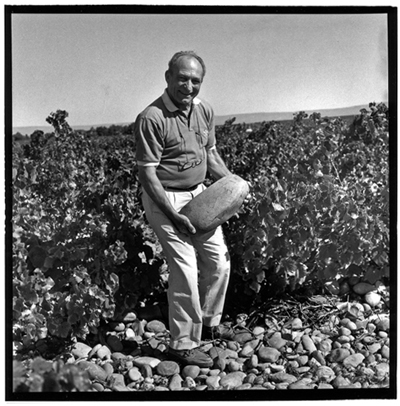
Credit: Kermit Lynch
IF ANYTHING CAN BE SAID to be genuinely innate about human taste it’s our appreciation and enjoyment of the flavors of ripe fruit. We came down from the trees already addicts to fruit sugars, the evolutionary biologists tell us, so it wasn’t something we had to acquire a taste for.
Fruity flavors were very likely the first thing we humans loved about wine, although that kick of mood-altering ethanol didn’t do anything to put us off.
You can admit this but still believe (as I do) that just because wine is made from fruit it doesn’t follow that it must be first and foremost fruity. This idea was the hobby horse of Robert Mondavi (see my obit here) who very early on in his career recognized that he could distinguish his California-made wine from that of Europe by emphasizing the inherently fruity character of the former. In comparative tastings he habitually badgered guests into conceding that while European wine was often good California wines were “just a bit fruitier” — and, by implication, just a bit better.
Later, the theme was picked up by Robert Parker, whose writing over the years in The Wine Advocate has had the effect of bringing the variant profiles of Old and New World wines, once rather sharply differentiated, closer together – mainly by giving high ratings to wines made with very pronounced levels of fruit and fruit sweetness.
Influencing Americans to privilege fruit above all else gave Mondavi an edge since the ripeness that came naturally in California was hard to replicate in most of Europe. As his views gained ground, the range of flavors and aromas considered acceptable in wine diminished. Secondary flavors, the kind that experienced tasters often describe in earth, soil, and mineral terms were either deselected in the vineyard or, if present, hidden behind stout walls of primary fruit.

A recent Central Bottle staff meeting in which we tasted a number of wines from the Loire’s westernmost vineyards prompted a lively discussion about minerality in wine – what it is, what it tastes and smells like, where it comes from. It’s an interesting subject and I don’t pretend to have gotten to the bottom of it. The subject isn’t a new one, but even a few years ago you wouldn’t have heard anyone who wasn’t quite sophisticated talk about the mineral aromas and flavors in wine. Today even casual wine drinkers seem comfortable with the concept.
You’ll hear minerality used to describe a broad range of perceptions, from forest floor, loam, and humus, to alluvium, gravel, slate, flint, wet stones, chalk, even basalt and coal. Minerals, it seems , can be perceived as solid and hard like granite, or powdery like stone dust or gypsum. But since few of us will have actually tasted any of these materials it seems fair to ask how we know what basalt and coal taste like, if anything, and whether the actual flavors of these minerals resemble in any way what we say we are tasting in our wine. Short of actually performing these taste tests, I’m not sure how we draw any conclusions.
Randall Grahm’s experiment accomplished one thing: it brought to light the faulty logic that wants to treat wine as if it were mineral water.
But this only part of the problem. While we talk about minerality as if the particular elements present in the soil were communicating their flavors into the vines and then into grapes, the research says that this kind of communication does not happen and is, in fact, impossible.
Master of Wine Bill Nesto, who teaches at Boston University’s Elizabeth Bishop Wine Resource Center, asserts that inorganic mineral compounds appear in wine solely in the form of mineral salts of which only sodium chloride (ordinary table salt) can be detected by tasting. You can read his entire essay (“Minerality is the OM of wine tasting”) here. Nesto argues that the only true mineral taste in wine is salinity.
This point of view is supported by science journalist-turned wine writer Jaime Goode, who presents essentially the same research in his book “The Science of Wine.” In it, there’s a striking account of winemaker Randall Grahm’s experiments with putting rocks into barrels with maturing wine to see if minerally flavor and aromas would be communicated. The stones had some effect on the wine, Grahm claims, adding “far more complexity and greater persistence on the palate,” but the alterations didn’t have the effect of making the wines taste more like rocks or gravel. When the health department found out what he was up to, they made him stop.
Grahm’s experiment accomplished one thing: it brought to light the faulty logic that wants to treat wine as if it were mineral water. Yes, acidic mineral waters absorb and hold in solution an array of inorganic compounds (magnesium, calcium, bicarbonate, sulphate) picked up in their long subterranean journeys, and it’s by means of these dissolved solids that mineral waters become imbued with flavors that can justifiably be called “minerally.” But this doesn’t at all describe the intereaction of minerals with vines or their fruit. Wine doesn’t yet collect underground and flow spontaneously from springs – although we can always hope.
I am personally partial to the view that what we call minerality is really just a name we give to a spectrum of flavors generated by fermented grapes that we don’t know what else to call. Indeed, it’s likely that many of these effects may be generated by fermentation itself, a view shared by food science author Harold McGee.
Goode presents the story of a winemaker in Pouilly Fume who is getting rather too much of the gunflint aromas wine from this part of the world can show. A consulting oenologist suggests ways to boost the fruit profile of his wine, and when he incorporates them his wine presents with more ‘normal’ and acceptable levels of flint. The story strongly suggests to me that the thing we call minerality may be present in most wines, but that big fruit can create a wall that keeps these secondary aromas and flavors from emerging.
The problem here can in part be attributed to the fact that wine is so complex chemically that we just don’t really know what’s going on. Until we do, it seems to me that the best policy will be to temper speculation about the possible sources of minerality in wine – certainly stop talking about it as if it were alcoholized mineral water – and just enjoy the ride.